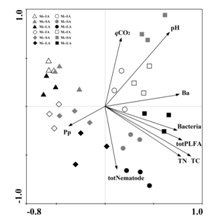The addition of fresh organic matter is known to modify both soil aggregation and soil biotic community composition. It was hypothesized that fertilization alters the composition of soil nematode and microbial communities in soil aggregates, and the interaction between nematodes and microbes can stimulate or inhibit microbial activity. Prof Sun led his group build a long-term fertilization experiment in an acid soil in subtropical China (Ecological Experiment Station of Red Soil, CAS). They investigated changes in nematodes and microbial communities among aggregate fractions after 9-year manure application. Nematodes, microbial communities, and metabolic quotient (qCO2) were examined within three aggregate size fractions (LA>2000 mm; SA 250-2000 mm; IA<250 mm) under four fertilization regimes (M0, no manure; M1, 150 kg N ha-1 y-1; M2, 600 kg N ha-1 y-1; M3, 600 kg N ha-1 y-1+ lime at 3000 kg Ca(OH)2 ha-1 3y-1). Aggregate fractions significantly affected the total number of nematodes and the abundance of bacterivores and plant parasits, with values following the trend of LA>SA>IA. Aggregate fractions also influenced microbial biomass and diversity that increased with decreasing aggregate size. However, the SA fraction had a significantly higher qCO2 than the IA fraction. The variations in the composition of nematode and microbial communities could be explained independently by fertilization treatments (44% and 48%) and aggregate size (6.0% and 21%), respectively. Soil total C and pH exerted the strongest influence on microbial biomass and total number of nematodes. The abundance of bacterivores showed a significant positive association with bacterial biomass, which could partly explain the significant negative correlation between the total number of nematodes and qCO2. The research confirmed that grazing on microbes by microbivores may decrease microbial activity, which provided a biological mechanism for organic fertilizer enhancing soil organic carbon storage in red soils (with a total area of 101.9 million ha in South China).
|

|
|
Figure Redundancy analysis (RDA) illustrating relationships among nematodes,
microbes, soil chemical characteristics, andqCO2. |
